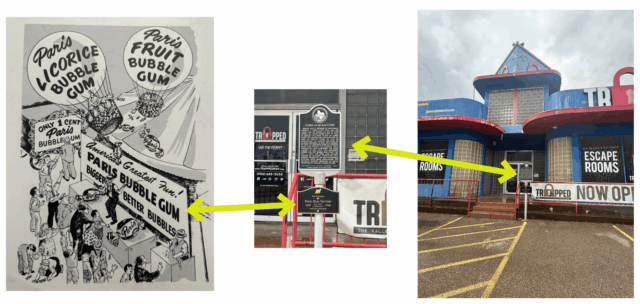This post is part of our blog series “Scholars Speak,” which features writing from our 2025 cohort of Preservation Scholars. Click the link to learn more about this donor-funded program that aims to increase the breadth of voices in the Texas historical narrative by placing students from underrepresented cultural and ethnic backgrounds in paid, 10-week long summer internship positions at the Texas Historical Commission.
Scholars Speak: From Bubble Gum to Labor History—Teaching with the Andy J. Paris Marker

This summer, I have been working on the Edumarkers Project with Alicia Costello, THC’s Historical Marker Program Historian. My project consists of creating kindergarten-12th grade local history lesson plans from official Texas Historical Markers. I decided to start with the Andy J. Paris Recorded Texas Historic Landmark (RTHL) marker located in my hometown of McAllen, Texas. Paris (1919-1997), a Greek immigrant who sold sweets in his Detroit, Michigan, tobacconist shop, was forced close shop due to WWII rationing. In 1942, in Mexico City, he found a supply of chewing gum and candies and established an import business in McAllen. By February 3, 1947, LIFE magazine had named him the “Bubble Gum King”.
What makes his story especially meaningful to me isn’t just the proximity of the factory to my home, but how it reflects the broader history of Mexican laborers in the United States during a critical period of growth and change. In my lesson plan, The Making of South Texas through Labor Relationships, I identify the working conditions faced by Latina factory workers in the early 20th century. The lesson plan uses primary sources, such as the 1932 survey conducted by the Women’s Bureau of the U.S. Department of Labor, to show students that out of the 15,453 women employed, 2,857 were Chicana workers, and 67% of them worked in factories. The lesson plan continues to discuss how 1938’s Fair Labor Standards Act changed how employers treated their workers based on their pay. The lesson plan then asks students to choose a profession in 1932 and compare changes to the same job today. Using the Paris Gum Factory historical marker, the lesson plan also has students debating whether figures like Paris were transformative business leaders or if they contributed to labor control and unfair practices.
The common theme I want to highlight in these lesson plans, and which I was able to through the Andy J. Paris marker, is labor in Texas. These lesson plans, created using local stories, will be used across the 20 Texas Educational Agency regions. By engaging students with stories from their own backyards, I hope to spark curiosity and civic awareness while showing that history isn’t just something that happened elsewhere — it happened here. Working with the Paris marker has not only reshaped how I see McAllen, but how I see public memory and the power of untold stories. I hope these lessons will inspire students to investigate their own communities with fresh eyes.
